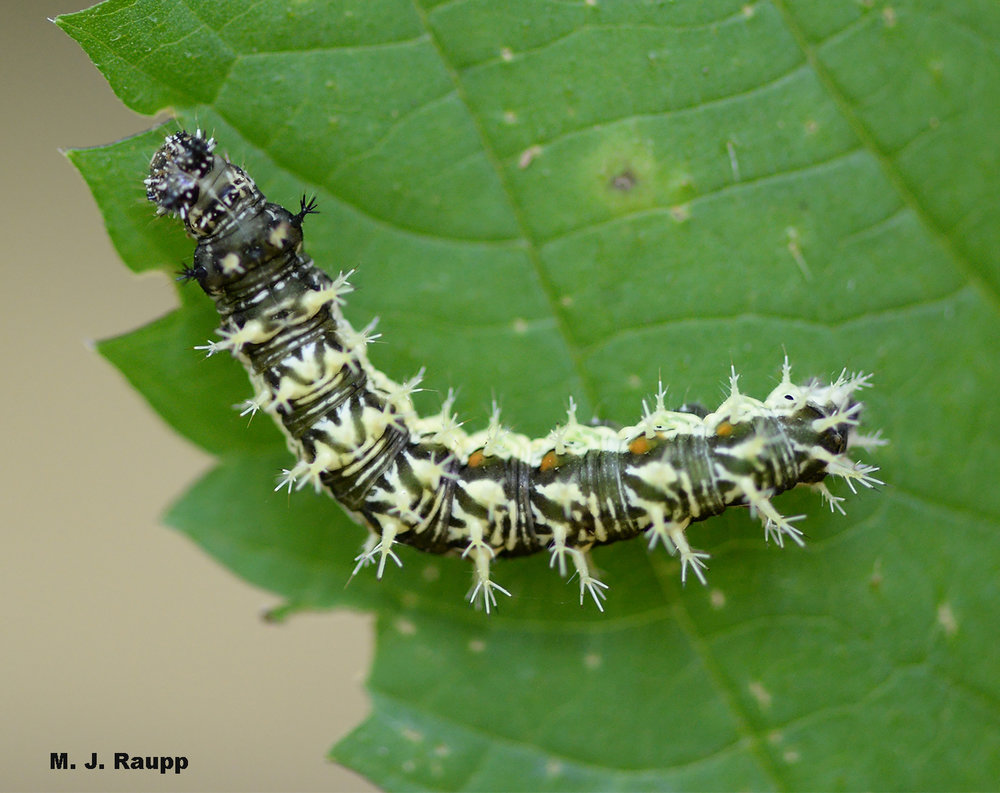Nettles and poop on the menu for the Eastern Comma butterfly, Polygonia comma

Angled wings with the mottled pattern of a dead leaf on the underside help the comma butterfly escape the searching eyes of predators. Note the bright comma-shaped mark on the hindwing that gives the comma its name.
Stinging nettles and feces don’t make Dr. Oz’s list for the ultimate keto diet, but for caterpillars and adults of the comma butterfly, these foods are just fine. Let’s return to Shenandoah National Park where last week we met tiger butterflies. This week we arrive at the picnic ground at mile post 62.8 for a visit with the clever comma butterfly. Here at the east end of the picnic grounds a trail descends to the spectacular South River Falls, the third highest waterfall in the park. As the trail snakes deeper into the gorge, the understory of a maturing deciduous forest is covered by stinging nettles. These members of the Urticaceae, with their stinging spines and tender leaves, wear the telltale signs of leaf-munching insects: sections missing from the margins, small and large holes riddling leaf blades. On one nettle we spotted the beautiful comma caterpillar basking in the dim light of the forest. Festooned with stout spines, a potent defense against the tender mouths of vertebrate predators, the caterpillar seemed content to rest in plain sight. Nearby, another late instar larva strolled across lichen colored stones, perhaps on its way to find a tender-leaved nettle for dinner. Early stages of the comma are not so bold and hide beneath leaves when not feeding.
Is this gorgeous comma caterpillar dashing off to find more food?
A little further down the trail we met hikers accompanied by their friendly canine companions. Fortunately, these pooches left deposits of former meals in small and large piles along the trail. Nutrient rich vertebrate scats are used by a variety of insects, including other brush-footed butterflies and broad-headed bugs we met in previous episodes. Dung is a food source particularly rich in nitrogen, an element necessary for the growth and development of all living organisms, including insects. Commas have added scat to their menu, which also includes rotting fruit and carbohydrate-rich tree sap.
Watch as a pair of comma butterflies battle to see who can be ruler of the dung.

Stout spines help defend the comma caterpillar from attacks from hungry predators.
While comma caterpillars are protected by nasty spines, adult commas use another form of defense – crypsis. Unlike other butterflies and moths whose wings have smooth rounded margins, comma butterflies and their kin have forewings and hindwings bearing deep notches that break-up the typical butterfly outline. This gives rise to the common name for these butterflies that are known as angle wings. In addition to the uncharacteristic body outline, the underside of the comma’s wings strongly resembles a dead leaf. This masquerade helps the resting comma avoid detection by the searching eyes of hungry predators. Fortunately, throughout its range in the DMV the comma has two generations each year so there is still plenty of time to go for a hike, find some scat, and enjoy the antics of the marvelous comma butterfly.
Acknowledgements
Bug of the Week thanks Dr. Shrewsbury for spotting the peripatetic comma larva that inspired this episode and Dr. Burghardt for confirming the identification of the larva. The marvelous web site Butterflies and Moths of North America was used as a reference for this episode.
This post appeared first on Bug of the Week


